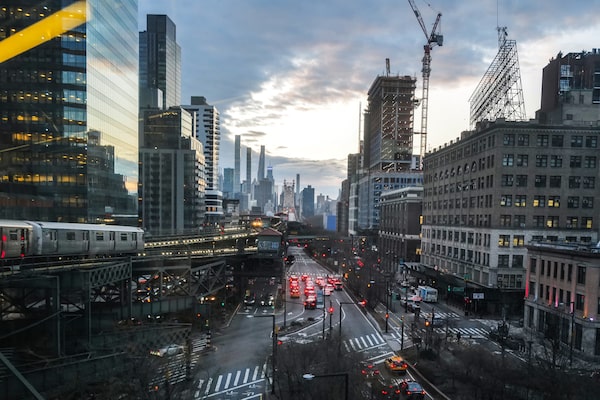
The Manhattan midtown skyline is in the background as cars move along the Queensboro bridge and a train rides by the Queensboro Plaza Station in the Queens borough of New York on April 1.CHARLY TRIBALLEAU/Getty Images
In the 1960s, North American cities experienced a popular revolt against development. It happened with good reason. It addressed a real problem.
It also made us poorer.
Urbanist Jane Jacobs and others fought against a type of bureaucratic, top-down development that put the car at the centre of everything; defined progress as bulldozing highways through old neighbourhoods; and dreamed of “slum clearance” to make way for centrally planned non-communities.
It was urban vandalism on a mass scale, largely conceived by progressive governments and financed by taxpayers. Outraged citizens were right to be outraged. They stopped such mistakes as Toronto’s never-completed Spadina Expressway.
Ms. Jacobs’s seminal 1961 book, The Death and Life of Great American Cities, understood successful cities as organic creatures. She wasn’t against change or growth, and celebrated a history of that in New York.
What she was against were planners and politicians who believed that, instead of organic evolution, they should impose their own centralized vision.
The top-down revolutionaries of postwar “progress” aimed to remake the city through zoning. The bottom-up, anti-development, counter-revolutionaries defeated them – but instead of paring back zoning, they added volumes of new rules to roadblock growth.
By the 1980s, it hadn’t just become harder to plow a highway through a community, or knock down a Beaux Arts jewel. It had become difficult to build almost anything, anywhere. Preservationist impulses were co-opted by people who wanted to make sure that nothing changed in their neighbourhoods. Developers and erstwhile new residents were redirected to the distant community of Not In My Backyard.
The result is a world where homeowners don’t just have property rights over their own property. They have significant control over their neighbours’ properties, and vice versa. Zoning had once been about making sure nobody built a factory next to your house. Now, it was about making sure nobody built a three-storey triplex next to your three-storey house.
That limited housing supply and raised housing prices in places where demand was highest.
It also delivered another bad outcome. It was hard to see, and all the more insidious: lower economic growth.
In 2019, economists Chang-Tai Hsieh of the University of Chicago and Enrico Moretti of the University of California, Berkeley, tried to estimate the cost of the “spatial misallocation of labour” from restrictive zoning.
They looked at American cities, and noticed something strange. The most productive and high-income U.S. metro areas are New York, San Francisco and Silicon Valley. The productivity gap between these areas and the rest of the country is wider than it was in the 1960s. As such, these three cities should have experienced decades of significant population growth. Lots of people from the rest of the country should have moved there, drawn by higher productivity and higher wages.
But that hasn’t happened. Even as California became the global centre of a booming tech industry, population growth slowed and eventually went into reverse. The state’s gross domestic product per capita is well above the U.S. average, yet in recent years its population has shrunk.
It’s unprecedented. It’s also the logical result of really, really bad public policy.
“The constraints on housing supply in the most productive U.S. cities,” Mr. Hsieh and Mr. Moretti write, “effectively limit the number of workers who have access to such high productivity. Instead of increasing local employment, productivity growth in housing-constrained cities primarily pushes up housing prices and nominal wages.
“The resulting misallocation of workers lowers aggregate output and welfare of workers in all U.S. cities.”
I’ll spare you the math and the models, but the bottom line is that highly restrictive zoning in economically dynamic places not only raises housing prices there, it leads to lower economic output nationwide. We’re all poorer if zoning makes it impossible for citizens of a country – particularly lower-income and middle-class people – to move to the part of the country where they could produce and earn more.
The most extreme case is Silicon Valley. Despite having what the two economists describe as “some of the most productive labour in the globe,” it is also extremely low density. “In a region with some of the most expensive real estate in the world, surface parking lots, one-storey buildings and underutilized pieces of land are still remarkably common due to land use restrictions.”
Between 2000 and 2023, the San Jose, Calif., metropolitan area’s population increased by just 205,000 people, or 12 per cent. Zoning reserved almost all of the land for low-rise, single-family homes, making it impossible for more people to move to the site of the highest-paying jobs.
The economists conclude “that a first-order effect of more housing in Silicon Valley” would be “to raise income and welfare of all U.S. workers.”
There’s a lesson here for Canada.
Fixing our long-standing housing shortage will take years. Fixing our economic productivity issues will also take years. But the two are not unconnected.
To the extent that we can loosen our zoning rules and approval processes, allowing developers to build more housing in existing neighbourhoods of the biggest cities, thereby allowing more Canadians to move to where the highest-paying and most productive jobs are, we will all be better off.
 Tony Keller
Tony Keller